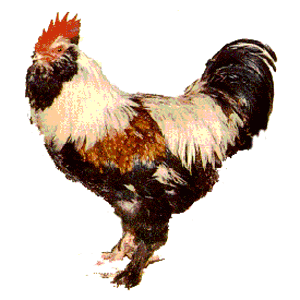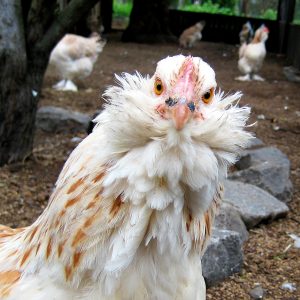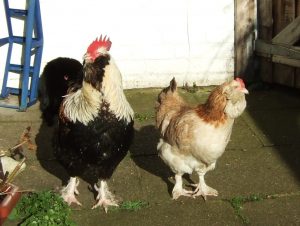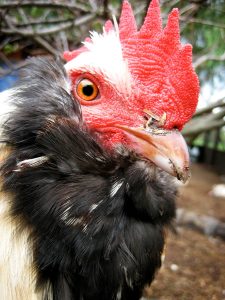
Faverolle Overview
Faverolle Chickens originated by breeding Dorkings, Houdans and Asiatices in the French village of Faverolle halfway through the 19th century. However, the breeds used to create this chicken were not well documented so we can’t know for sure whether these were the only breeds used.
They were initially bred as a utility bird that could lay throughout winter and still make for good table poultry. They were created as a dual purpose breed and were imported into England in 1886 where they were used for crossing with other breeds to produce excellent table fowl.
The Dorking and Houdan ancestry can be spotted in their 5 toes! Very unusual.
Males should weigh around 8lbs (3.6kgs) and females should weigh around 6.5lbs (3kgs).

Eggs
Size
Medium sized eggs
Color
Light brown color eggs
Production per year
160 eggs per annum
When do they start laying eggs?
From 20 weeks
Faverolle Characteristics
Temperament / Are they good as pets?
They’re very friendly to humans and love being held. They’d be really good pets if you have any children as they’re non-aggressive.
How do I tame Faverolle chickens?
These chickens love to be picked up and this is a great way of taming them and getting them used to human contact. Alternatively, you can feed them straight out of your hand in order to tame them.

How many do I need to buy?
Chickens get lonely by themselves and should always be with at least 1 other chicken. The more the merrier though and we would suggest a small flock size of 6.
How much space do they need?
This breed doesn’t mind being confined and can be kept in a run which has 25 square feet per chicken.
Will they mix with my other chickens?
They can be mixed with other chickens but they may be bullied or even bully other birds, so make sure to keep an eye on them.
Appearance
The Faverolle chicken is one of the heavier breeds and have a very broad body but small wings. There are lots of different color varieties but the most popular one is salmon pink. They have five toes with the last one pointing up into the air.
Their legs are feathered but you can see the pink of their legs poking through. They have a small neck and a red single comb.

Feeding
What should I feed them?
From when they hatch until they are 6 weeks they should be fed growers mash. This typically has a higher protein content than most chicken feed and comes in a smaller form so that they can easily ingest it.
When they are 6 weeks old slowly introduce chicken pellets; this normally has between 15-16{cfcd481556a8b43fba6af451761032bd323e94372a0c1e607} protein content and is just chicken feed in a pellet form.
Before your chickens get to laying age at 16 weeks you can give them layers mash or pellets, which has 16{cfcd481556a8b43fba6af451761032bd323e94372a0c1e607} protein content. This feed has everything they need to support them with egg production.
How much should I feed them?
Chickens usually eat around ¼ of a pound (113g) of feed each a day. Start by giving them this amount and then vary the weight depending on whether you think this is too much or too little for your chickens.
You can either feed them in the morning or you can leave the feed in the feeder for them to eat throughout the day as they please and then check how much of this they have eaten.
What can’t they eat?
There are a wide range of things that are best kept far away from chickens; the main two foods being chocolate and beans. Chocolate contains theobromine and beans have phytohemagglutinin in, both of which are very dangerous if ingested and can be potentially fatal.
It should also be noted that chickens shouldn’t be fed any moldy food or food that has gone off as the bacteria and mold can make them unwell.
What do I need to keep chickens?
The main thing you need to keep chickens is a coop that has 11 square feet per chicken. Inside the coop there should be a perch for each bird to catch some sleep on during the night.
There should also be laying boxes which you can fill with wood shavings. To protect your chickens at night you need a fence going around the perimeter and over the top of the coop that should be sunken at least 8 inches into the ground.
They need a run to stretch their legs in during the day, this should be at least 25 square feet per chicken but the more the better. You should make sure that your chickens have access to water at all times and try and find a stable water container that they can’t knock over too easily.
There should be grit on hand as well as this is a key ingredient in egg production.
